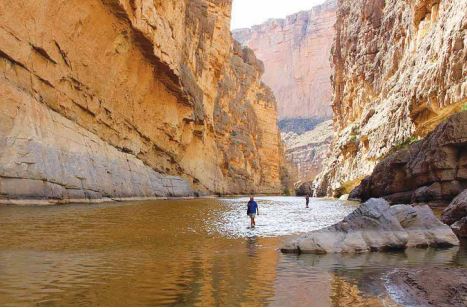
Big Bend is one of the most remote areas in the United States. It took us five hours to drive from El Paso to Marathon on excellent paved roads, and yet we rarely saw another car.
As we wound our way through the West Texas Mountains, the scenery was captivating. Big Bend is named for the vast curve of the Rio Grande River in remote southwest Texas. It is wildly beautiful country used for hiking, camping, river running, horseback riding, birding, and attracting nature lovers.
It includes three counties: Brewster, Jeff Davis, and Presidio. Sparsely populated, arid, and rugged, it contains the Chisos and the Davis Mountain ranges, comprising 4,000 square kilometres of public lands, including Big Bend National Park and Big Bend Ranch State Park along the north side of the Rio Grande.
It is also home to the McDonald Observatory, with some of the largest telescopes in the world. The Visitors Center includes a theatre, gift shop and café.
The towns we visited were Alpine (nearest to the centre of Big Bend National Park), Marfa, Fort Davis and Marathon, all around 50 kilometres apart.
The Spanish arrived in the 1500s, but never settled this area. Nor did the Mexicans when they owned it. It was considered uninhabited land because the Mescalero Apache and the Comanche controlled it. After the Civil War, military posts were established, manned by Buffalo Soldiers who were expected to control the area and make it safe for settlers and mail coaches.
Visiting Fort Davis was like taking a step back in time. High in the Davis Mountains and surrounded by the Chihuahua Desert, the quiet little town is a place to enjoy the sun. Most of the businesses are centered around the county courthouse or along Main Street. Fort Davis takes its name from the military post that was established near here in 1854, between San Antonio and El Paso. Manned by Buffalo soldiers of the 9th U.S. Cavalry, it was designated a National Historic Site after the fort closed. Many of the buildings have been restored, so it is an excellent example of a frontier post. The town continued to grow as an important ranching centre, and tourism played a role because wealthy vacationers from the Gulf Coast came in the summer to enjoy the mild climate of the high desert.
The McDonald Observatory is a world leader in astronomical research because it benefits from some of the darkest night skies in the United States and is 6,790 feet above sea level. The Visitors Center is the starting point for tours, with Star Parties held on Tuesday, Friday and Saturday evenings. The sky is absolutely amazing from this location. An astronomer used a laser beam to point out constellations, calling them by name and providing interesting facts about the night sky. There are 88 official constellations, many named by the ancient Greeks. Orion was one of the brightest, and most familiar was the Big Dipper. It was a fascinating experience.
Alpine is an interesting town with one of the nicest hotels, the Quarter Circle 7. It is also home to the Sul Ross State University and the Museum of the Big Bend.
While the Big Bend area is a long way from major population centres and public transportation is limited, an Amtrak station and a Greyhound bus line serve Alpine and the museum is a must-see. It showcases 11,000 years of history and honours the contributions of native Americans, Spanish, Mexican and AngloAmerican settlers.
In 1971, a geology student discovered a long, narrow hollow bone from a wing of a pterosaur or flying reptile. Its wingspan was between 36 and 39 feet. It walked on all fours and had leathery wings. A model of this strange bird hangs from the ceiling of the Museum. Matt Walters, Curator of Collections, gave us a tour of the museum and the map room, featuring more than 2,000 historical maps focusing on Texas. Marathon is interesting with the historic Gage Hotel (1927) anchoring this quaint town of 450 people. It calls itself the “Gateway to the Big Bend,” which is about 70 kilometres away.
We were treated to a memorable breakfast at Eve’s Garden B&B. Yeast Waffles were divided in four with whipped cream and maple syrup and each quarter covered with raspberries, strawberries, blueberries and bananas. The recipe is on the Internet. Try it; you will love it. The Gage Gardens is a 26-acre landscaped park provided by the Gage Hotel to be used for weddings, receptions, dancing and contemplation. Native plants, flowers, fruit trees, a pond and beautiful fountains provide instant relief from the desert sun. The hotel offers the 12 Gage Restaurant, a pool and well-stocked gift shop. What is unexpected and beautiful is a tranquil spa with a wide range of services for rejuvenating in West Texas. Big Bend is spectacularly beautiful and rich in history. The ideal time to visit includes October to April when evenings are cool and wild flowers are in their prime.
-Doreen Kerby
